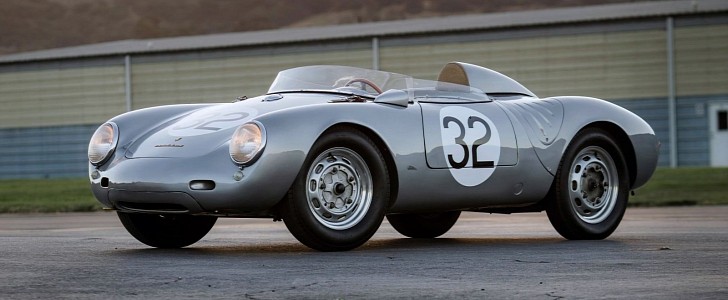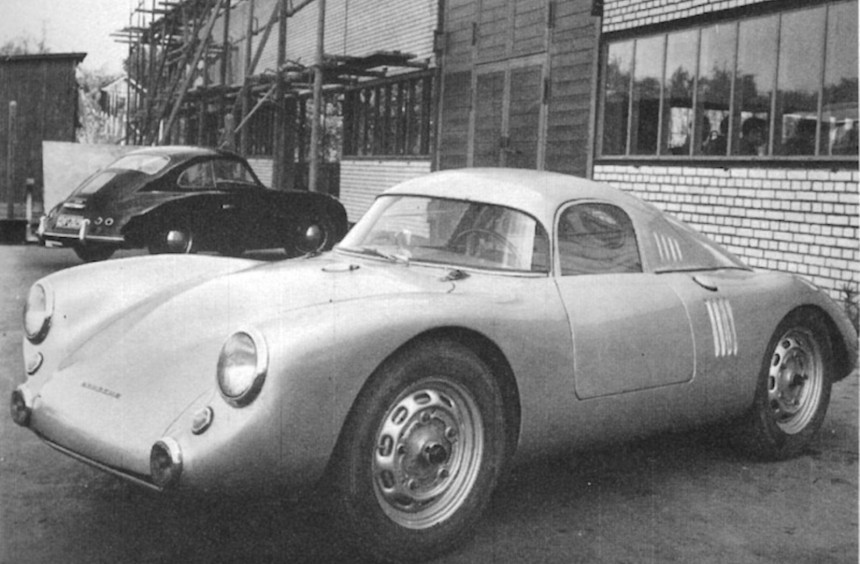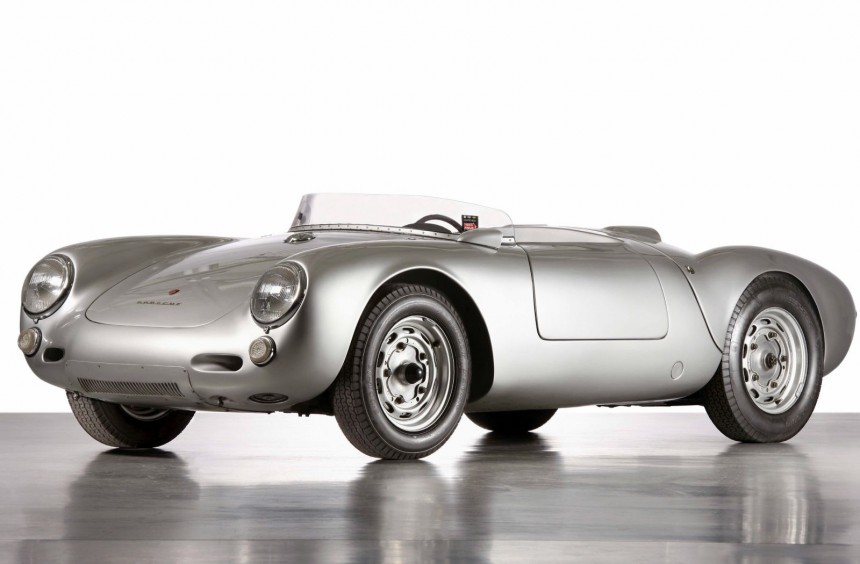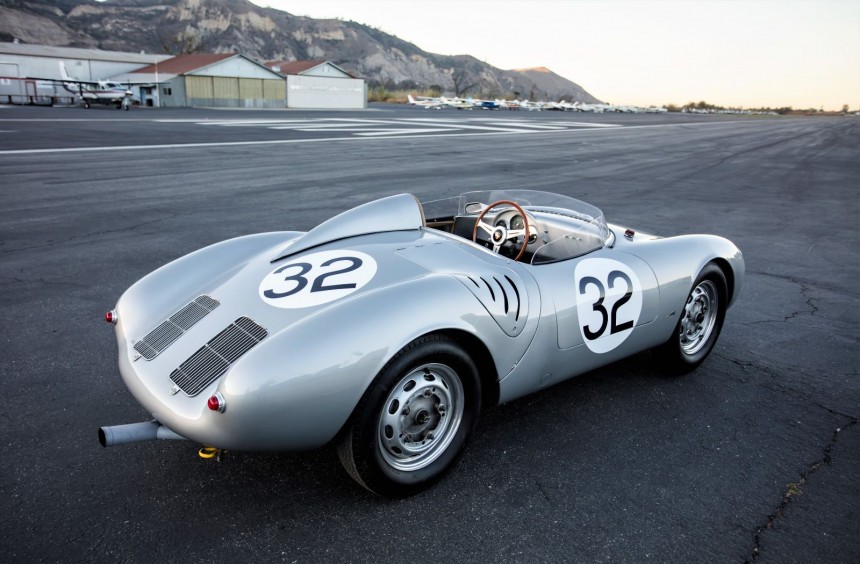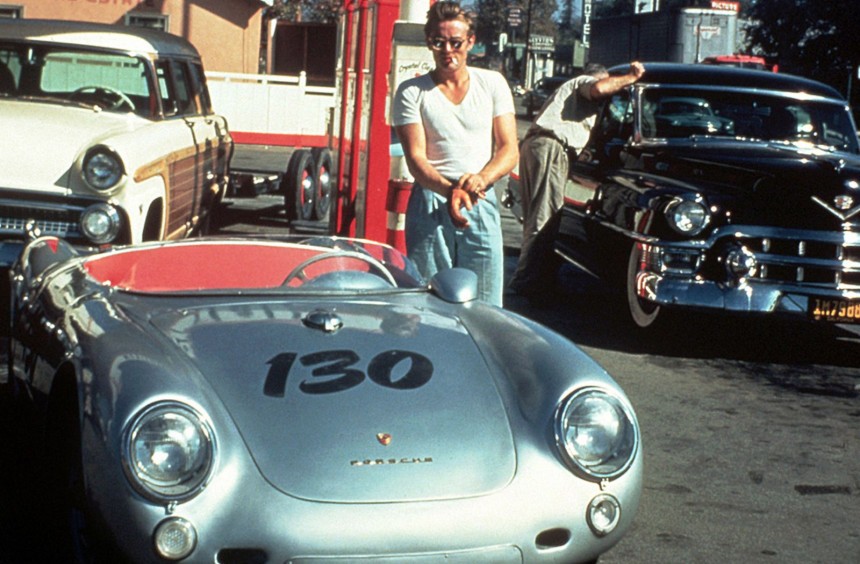Powered by a mid-mounted flat-four, and almost half as small as an American sedan of the era, the 550 looked more like a toy than an actual racecar. However, from its track debut onwards, it became the automotive equivalent of David by mercilessly slaying Goliaths in the world’s most famous races.
In 1948, Porsche introduced its first mass-produced model, the 356. It was the brainchild of Ferry Porsche who – just like his father – was a talented designer and engineer. He was also the owner of several sports cars, but his favorite was a convertible Volkswagen with a supercharged engine. As he stated in a 1972 interview for Panorama magazine: “if you had enough power in a small car, it was nicer to drive than if you had a big car which was also overpowered.” This was the philosophy that gave birth to the 356, as well as its race-bred sibling, the iconic 550 Spyder.
In 1951, an amateur race driver by the name of Walter Glöckler worked with Ferry Porsche to extensively modify several 356 chassis into two-seat racing prototypes. These cars showed a lot of promise, so Porsche decided to start a separate project and develop an entirely new machine, a move deemed crucial for boosting the sales of the 356.
Slotted between type 549 - the company’s internal designation for a truck transmission, and type 551 - another gearbox design, work on the type 550 project began in 1952. A year later, the first two prototypes were finished and after being thoroughly tested, they were ready to race.
They were built around a lightweight spaceframe chassis covered with a curvaceous aluminum body. Unlike the vast majority of manufacturers, Porsche opted against developing a large displacement engine and instead chose to go with a small type 502 1.5-liter pushrod boxer. For better weight distribution, it was placed between the rear axle and the passenger compartment, making it one of the first mid-engine racers of the era.
These early prototypes were conceived as coupes with removable hardtops, a feature aimed at improving aerodynamics, but for the 1953 season opener at Nürburgring, chassis 550-01 would go on to race without a roof, despite the heavy rain. Much to everyone’s surprise, it managed to win the 1,500cc class with Helmut Glöckler (Walter’s cousin) behind the wheel. The other car (chassis 550-02) made its debut at the 12-Heures d’Hyeres in France, a month later. It failed to finish due to mechanical issues, but it was repaired in time for the 24 Hours of Le Mans where it finished first in its class and 15th overall.
Encouraged by these results, Porsche continued to refine the design and would go on to build 13 additional prototypes. While the first two were powered by ethanol-burning type 502 engines and came with bodies crafted by Frankfurt coach builders Weidenhausen, subsequent cars received the new Ernst Fuhrmann-designed type 547 quad-cam powerplant as well as upgraded bodies, most of which were fabricated by a bigger company called Weinsberg. The removable hardtops were abandoned in order to shed weight and each unit came with unique features, so none were identical.
In 1953, chassis 550-03 and 550-04 returned to the renowned Carrera Panamericana in Mexico, a race where both cars were unable to finish a year earlier, due to fuel pump issues. This time around, they were powered by the new, more reliable 117-hp 547 quad-cam engine which ran problem-free, enabling the 550 driven by Hans Herrmann to finish 3rd overall and first in its class. Thanks to this feat, the performance-oriented 547 boxer became known as the Carrera engine, and the 356 trims that were later equipped with it were marketed under the same nameplate.
The 550 Spyder prototypes continued to be raced by the company’s factory teams in various competitions until 1955. They piled up class wins in virtually every event they entered, proving the superiority of Porsche’s small and nimble design.
That year, the first production versions were completed. With numerous refinements, these variants were used as factory racecars but were also sold to privateers. A year later, an evolved version called 550A was introduced. With a lighter and stiffer chassis, more aerodynamically efficient bodies, and 135-hp engines mated to five-speed transmissions, they were even more dominant and one of them gave Porsche its first overall win in a major race, the 1956 Targa Florio. Driven by Umberto Maglioli, it managed to outclass bigger, more powerful cars like the Ferrari 860 Monza, Maserati 300S, or the Mercedes-Benz 300 SL. From this point on, the 550 Spyder became known as the Giant Killer.
Sadly, not all of its victims were bigger, more powerful sports cars. A year before the Targa Florio victory, legendary Hollywood giant James Dean would lose his life behind the wheel of a newly acquired 550 Spyder he nicknamed Little Bastard.
Although it was a full-blown racecar, this was the 1950s and it could be registered for road use. Dean had plates on his 550 but planned to tow it to an event. He changed his mind after a member of his team suggested that he should drive there to break the car in and gain more experience behind the wheel. While speeding on Route 466 in California, he ended up colliding with a massive 1950 Ford Tudor at the junction with Route 41. The impact propelled the small, aluminum-bodied Porsche into the air, flipping it multiple times. Dean was rushed to the hospital a few minutes later, but was pronounced dead on arrival.
Despite this unfortunate event, the 550 Spyder will be remembered as one of the most revolutionary racecar designs in history. It won its class in virtually every competition it entered and showed the world that a small, lightweight design can be extremely successful, even if it wasn’t powered by a big engine capable of delivering hundreds of horses.
It transformed Porsche into a household name among car enthusiasts and laid the foundation for the company’s future motorsport ventures.
Only 90 units were built from 1953 to 1956, and most of them have survived. They are highly collectible and rarely change owners, but some units have been auctioned off in recent years. One example is a 550A that was sold in 2018 at an RM Sotheby's event, fetching no less than $4.9 million.
Thanks to YouTube user 67merlin1, you can hop aboard a 550 Spyder for a breathtaking lap around the Nürburgring Nordschleife.
In 1951, an amateur race driver by the name of Walter Glöckler worked with Ferry Porsche to extensively modify several 356 chassis into two-seat racing prototypes. These cars showed a lot of promise, so Porsche decided to start a separate project and develop an entirely new machine, a move deemed crucial for boosting the sales of the 356.
Slotted between type 549 - the company’s internal designation for a truck transmission, and type 551 - another gearbox design, work on the type 550 project began in 1952. A year later, the first two prototypes were finished and after being thoroughly tested, they were ready to race.
These early prototypes were conceived as coupes with removable hardtops, a feature aimed at improving aerodynamics, but for the 1953 season opener at Nürburgring, chassis 550-01 would go on to race without a roof, despite the heavy rain. Much to everyone’s surprise, it managed to win the 1,500cc class with Helmut Glöckler (Walter’s cousin) behind the wheel. The other car (chassis 550-02) made its debut at the 12-Heures d’Hyeres in France, a month later. It failed to finish due to mechanical issues, but it was repaired in time for the 24 Hours of Le Mans where it finished first in its class and 15th overall.
Encouraged by these results, Porsche continued to refine the design and would go on to build 13 additional prototypes. While the first two were powered by ethanol-burning type 502 engines and came with bodies crafted by Frankfurt coach builders Weidenhausen, subsequent cars received the new Ernst Fuhrmann-designed type 547 quad-cam powerplant as well as upgraded bodies, most of which were fabricated by a bigger company called Weinsberg. The removable hardtops were abandoned in order to shed weight and each unit came with unique features, so none were identical.
The 550 Spyder prototypes continued to be raced by the company’s factory teams in various competitions until 1955. They piled up class wins in virtually every event they entered, proving the superiority of Porsche’s small and nimble design.
That year, the first production versions were completed. With numerous refinements, these variants were used as factory racecars but were also sold to privateers. A year later, an evolved version called 550A was introduced. With a lighter and stiffer chassis, more aerodynamically efficient bodies, and 135-hp engines mated to five-speed transmissions, they were even more dominant and one of them gave Porsche its first overall win in a major race, the 1956 Targa Florio. Driven by Umberto Maglioli, it managed to outclass bigger, more powerful cars like the Ferrari 860 Monza, Maserati 300S, or the Mercedes-Benz 300 SL. From this point on, the 550 Spyder became known as the Giant Killer.
Although it was a full-blown racecar, this was the 1950s and it could be registered for road use. Dean had plates on his 550 but planned to tow it to an event. He changed his mind after a member of his team suggested that he should drive there to break the car in and gain more experience behind the wheel. While speeding on Route 466 in California, he ended up colliding with a massive 1950 Ford Tudor at the junction with Route 41. The impact propelled the small, aluminum-bodied Porsche into the air, flipping it multiple times. Dean was rushed to the hospital a few minutes later, but was pronounced dead on arrival.
It transformed Porsche into a household name among car enthusiasts and laid the foundation for the company’s future motorsport ventures.
Only 90 units were built from 1953 to 1956, and most of them have survived. They are highly collectible and rarely change owners, but some units have been auctioned off in recent years. One example is a 550A that was sold in 2018 at an RM Sotheby's event, fetching no less than $4.9 million.
Thanks to YouTube user 67merlin1, you can hop aboard a 550 Spyder for a breathtaking lap around the Nürburgring Nordschleife.
